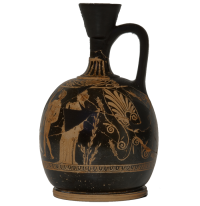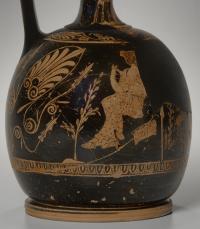Aphrodite with Poseidon and his loves: Amymone (the Danaid) seated at center and Amphitrite (his wife) standing at right
Learn more about the object below
Poseidon, the god of the sea, generally holds a trident, the three-pronged harpoon that is his particular weapon. On this vase from the Yale collection, however, he stands at ease in a fecund landscape suitable for the goddess of erotic love, Aphrodite. He and the women to either side of him are surrounded by laurel branches blossoming with buds enhanced by applied gold; the hare, a common element in vase-paintings of courtship, also comes to symbolize the object of pursuit in the serious sport of love. The powerful god stands at ease as he contemplates the woman before him, Amymone.
In ancient mythology, Amymone, one of Danaus’ 50 daughters, was on a mission to fetch water when she was attacked by satyrs. Poseidon rescued her from these predators only to pursue her himself. Afterwards he struck his trident to the ground to create a spring for Amymone. The water-jug beside her on this lekythos recalls this story and assures her identity even without the inscription once evident above her. The crown-shaped pillow that she grasps is also a clue, depicting the cushion she used to support the water-jug on her head. Amymone is the center of this scene, object of the gaze of all the others, her dress gleaming white.
Whether as a sea-nymph or a daughter of Oceanus, her associations with the sea make Amphitrite well suited for her place as bride of Poseidon. In art, she sometimes holds a fish, but more often she can be identified only by inscription or because she takes her place by Poseidon’s side. On this lekythos, the emphasis is on her beauty. She lifts the cloth of her garment, a gesture displaying the beauty of the fabric. She wears a diadem in her hair.
Nowhere else do Amymone and Amphitrite occur together in a single scene. But there is no question of their identities on this vase; all figures are named by inscriptions. The presence of Aphrodite suggests a possible explanation for this unique situation. Like Amphitrite, she makes manifest the seductive beauty of her clothing by lifting the cloth from her shoulder. Her hair is bound with ribbons; she has beside her a chest of the sort used to hold jewelry. All of the female figures emanate the erotic power which she represents. The subject is well suited to this squat lekythos, a shape intended for perfumed oil.
Label texts by Rebecca R. Sinos, Professor of Classics, Amherst College.
Suggested reading:
Carpenter, Thomas. Art and Myth in Ancient Greece: A Handbook. London: Thames and Hudson, 1991.






